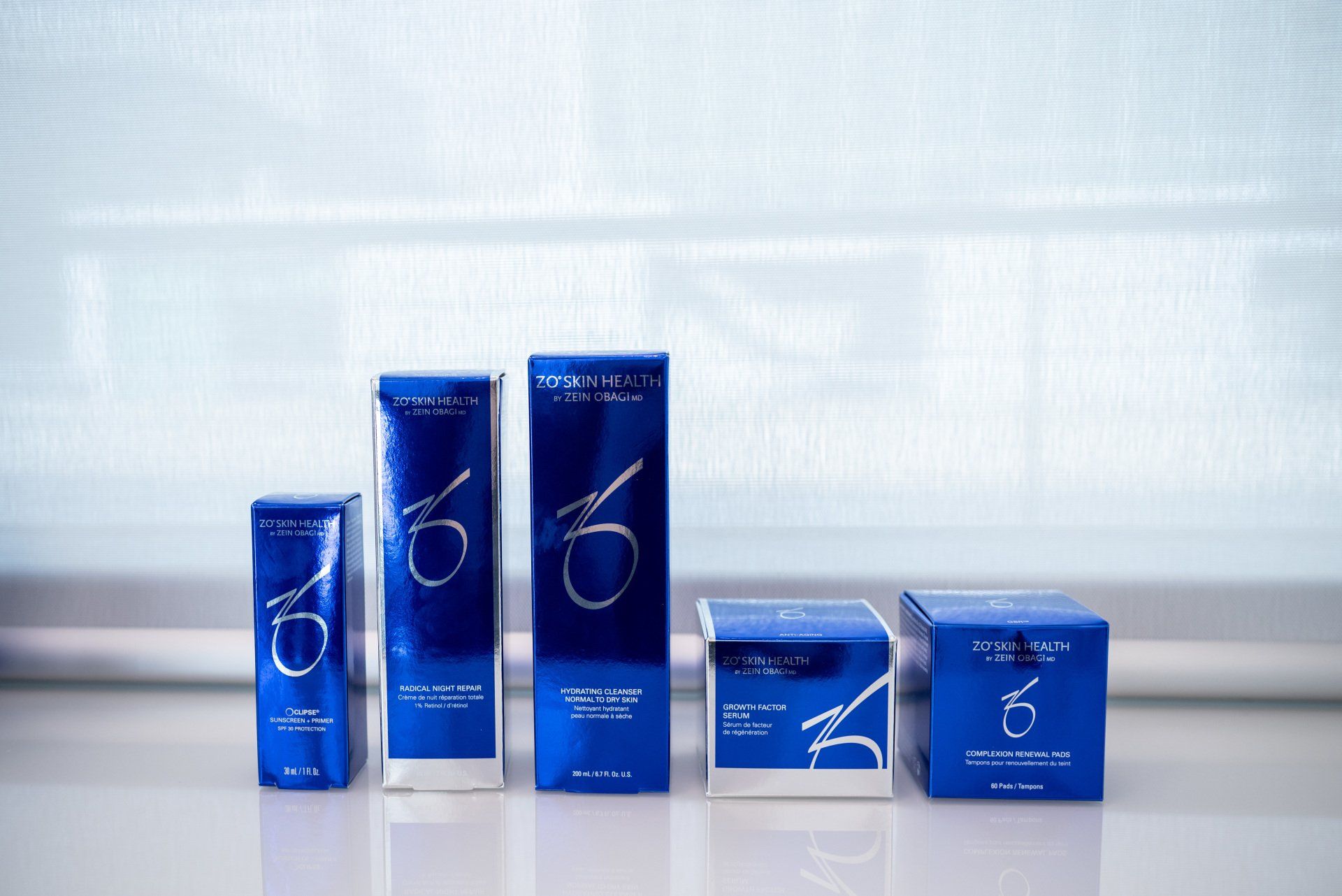
MEDISPA CONCEPT
The medispa is a concept that originated in the USA. It is a hybrid between a medical clinic and a day spa, run under the supervision of a highly trained and specialised doctor, in this case Ms Fitzgerald, who is a consultant plastic, reconstructive & aesthetic surgeon.
All treatments are performed by Ms Fitzgerald, or by an experienced laser/ aesthetic nurse, depending on the treatment involved, and your preference.
Why choose the Medispa at Fitzgerald Plastic Surgery?
Our training and expertise
We have a unique skill-set, that will ensure the full spectrum of treatments for your concerns can be considered and offered. Everything from non-prescription topical skincare, non-surgical options like injectable treatments and lasers, minimally-invasive surgical procedures, and comprehensive surgical treatments such as eyelid lifts (blepharoplasty) and facelifts, can be discussed with you by a consultant who is fully trained in these procedures. Please note, however, that face and neck lifts are no longer offered by Ms Fitzgerald, as the number of patients seeking these treatments has diminished so dramatically.
Our laser experience
No other consultant in the country has completed the level of fellowship training in medical lasers that Ms Fitzgerald has done. In a country where literally anyone can purchase and use a medical grade laser, the skill and training of the operator of that laser is pivotal to achieving safe and effective results. Our nurses have extensive and comprehensive training and experience in medical lasers.
Our products and services
We offer in-office treatments and medical grade skincare, all of which are meticulously researched, and which have been chosen for our facility on the basis of robust scientific data and clinical evidence of efficacy. Our services include:
- ZO Skin Health
- Laser photorejuventation (photofacial)
- Laser hair removal
- Medical laser hair reduction
- Microneedling
- Platelet-rich plasma (PRP)
- Skin peels
- Medical microdermabrasion
- Anti-wrinkle injections
- Dermal fillers
- Treatment of excessive sweating (hyperhidrosis)
Consultations & fee structure
A consultation fee is payable by all clients on their first appointment. We will always endeavour, at the time of booking, to establish whether an appointment with the nurse or consultant plastic surgeon, is more appropriate in your particular case.
For appointments with the aesthetic nurse, the consultation fee may be offset in full against recommended treatments or products purchased within six months of the initial appointment. Once six months has lapsed, further charges will apply for treatments/ products.
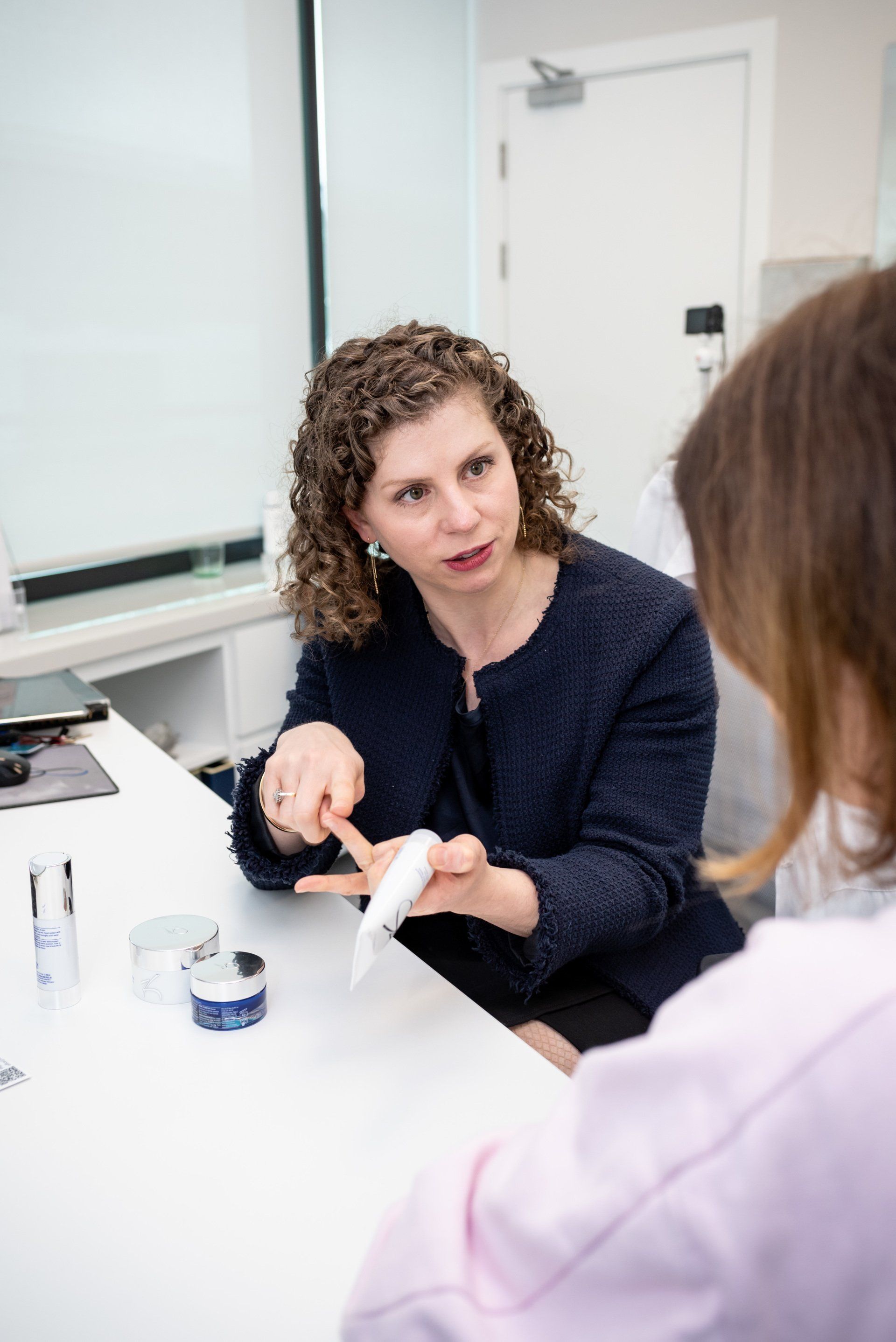
SKIN HEALTH CONSULTATION
Skin health: ask the experts
Healthy skin is having a moment. It is impossible to open a magazine, scroll through Instagram, or even meet a friend for coffee without hearing about the latest greatest skincare product or treatment. The range of treatments and products available can be overwhelming, and with the proliferation of self-styled experts (many of whom are unqualified), sponsored endorsements, and a blurring of the lines between the beauty and medical industry, it can be very difficult to establish who is advising you, and whether that advice is any good. Many clients attend with stories of treatments that failed to meet their expectations, large collections of barely used (and sometimes very expensive) products which did not suit their skin, feeling confused about what might work in their particular circumstances, or worried about potential adverse effects or downtime associated with treatments.
Our philosophy at Fitzgerald Plastic Surgery is simple: good skin is achievable for virtually everyone, and we have the qualifications and experience to help a very high proportion of individuals who seek our help. Occasionally, referral to a consultant dermatologist is indicated, and we will advise you without hesitation if we feel that this is the best course of action for you. The commonest situation where this occurs is where someone is a potential candidate for systemic treatment of acne (e.g. Roaccutane).
Your skin health consultation
The first step towards glowing, healthy skin, is to attend for a consultation with our highly experienced aesthetic nurse. During this consultation, we will analyse your skin carefully, help you to define your skincare goals, and suggest products and treatments that are designed to work with your lifestyle, budget, and timescale. Before coming in, it can be very useful to have a think about your major and minor concerns, how quickly (or slowly) you want to see a result, how you feel about downtime and side effects like redness, peeling, and bruising, and your budget. It can also be useful to either note down or bring with you products that you are currently using: where possible/ advisable, we like to suggest tweaks to your current regime, rather than suggesting that you throw everything in the bin, as we are conscious that you may already have invested in skincare products. Also have a think about your exposure to sun, upcoming holidays, and current habits around sunscreen, as this may have a bearing on our recommendations to you.
There is a fee associated with the skincare consultation. This may be offset in full against recommended products, or treatments with the aesthetic nurse, purchased within six months of your appointment. Should a laser patch test be deemed necessary, it is included in the consultation fee. If the nurse feels that a consultation with Ms Fitzgerald is required for your particular concerns (for example should an injectable treatment or surgical procedure be something you wish to discuss), then such a consultation can be arranged for you.
Follow up
We’ve all done it: bought a whole load of new products with great enthusiasm, been meticulous at first, but then let things slide, and become confused about what we were supposed to do and when. We don’t want this to happen to our clients, and therefore we offer comprehensive support and follow-up for clients starting a new skincare regime. In addition to written instructions, we love to take a look at your skin after a couple of weeks on your new regime. Please book this complimentary review appointment following your initial appointment. We will also stay in touch by phone, and you are welcome to drop us an email or telephone at any stage should you have any concerns or require clarification on any aspect of your skincare regime.
Purchasing products
We realise that people live busy lives, and if it suits you to have your products sent out to you, we are delighted to do this for you. You can request products via our online product showroom: we will check your requested products against the recommendations we have made for you, and then contact you to arrange payment and delivery/ collection details. Please note that this is not an online shop, and all product requests must be verified against your previously recommended products before purchase.

ZO SKIN HEALTH
ZO Skin Health, Inc.™ develops and delivers innovative skincare solutions that optimise skin health based on the latest advances in skin therapy technologies, unique delivery systems, bioengineered complexes, and exclusive formulations. By providing comprehensive skincare programs for physicians and their patients, ZO Skin Health, Inc.™ bridges the gap between therapeutic treatments and daily care, allowing patients to experience continuously healthy skin regardless of their age, ethnicity or unique skin condition.
The ZO Skin Health™ and ZO Medical ™ range includes cleansers, exfoliants, toners, and treatments for specific concerns such as lines and wrinkles such as enlarged pores, acne, rosacea (skin redness), and for the hands and body.
At Fitzgerald Plastic Surgery, we stock a selection of ZO Skin Health™ and ZO Medical ™ products. These are powerful products, and the best results are obtained when a bespoke regime is designed for you. In order to ensure that our clients are getting optimal results from their skincare regime, and avoiding unwanted side effects from the use of these potent skincare products, we provide a comprehensive skin consultation at your first visit. During this consultation, you will meet with the aesthetic nurse. She will analyse your skin carefully, help you to define your skincare goals, and suggest products and treatments that are designed to work with your lifestyle, budget, and timescale. The cost of this consultation may be offset in full against any products or treatment received. We suggest that all clients considering starting a regime that involves the use of ZO™ or Obagi™ products attend for this consultation, and certain products are only available to clients who have had this consultation, which is held in conjunction with Ms Fitzgerald if necessary (where a regime including prescription products is being considered).
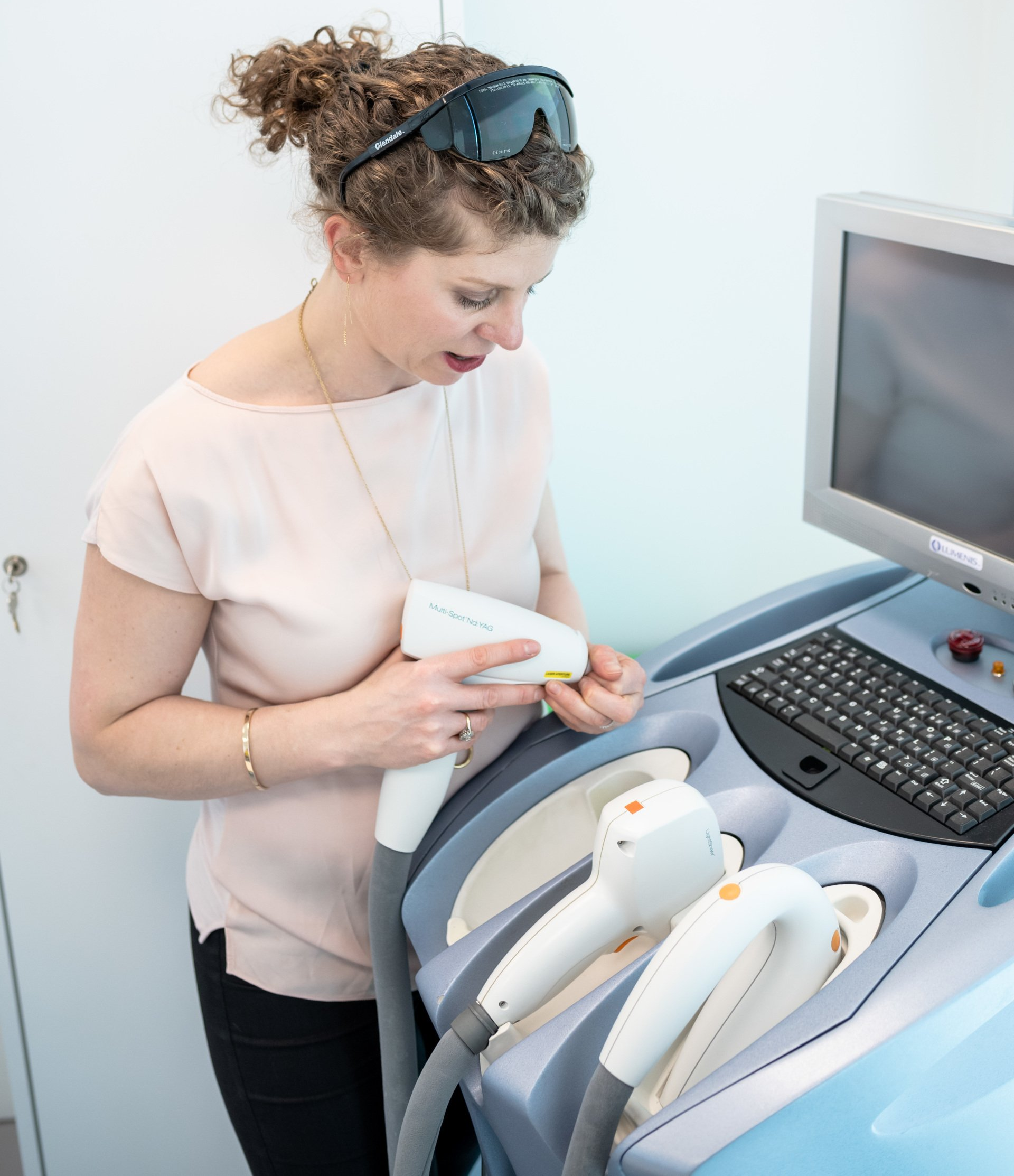
LASER PHOTOREJUVENATION
WHAT IS IT?
Laser photorejuvenation can be used to help restore the skin’s youthful appearance. It is a safe, non-invasive solution, providing superior cosmetic results. At Fitzgerald Plastic Surgery, we use the Lumenis IPL system. This technology is considered the “gold standard” for photorejuventation, as well as treatment of rosacea and vascular lesions. The efficacy of this advice has been proven in over 80 peer reviewed papers.
Treatments are especially effective for improving the appearance of the face, neck, chest and hands. With this treatment you can resume normal activities immediately (although we do recommend against strenuous exercise for the rest of the day, for your comfort). Some, but not all, people will describe feeling a little sunburned at the treatment. This is a non-invasive treatment, and does not require any injections or other invasive procedures.
How does it work?
IPL is intense pulsed light. A very bright beam of white light is emitted from the machine: this is them filtered to a specific wavelength. This filtered light is then taken up by different colours (targets) within the skin. These targets include brown pigmentation (seen with sun damage and age spots), redness (caused by broken blood vessels and background redness/ erythema seen in certain skin conditions, and fibroblasts, which are the cells responsible for making new collagen in the skin. During a photorejuvenation procedure, different filters are typically applied, allowing layering of treatment, and targeting of multiple endpoints such as reduction in pigmentation and redness, and promotion of collagen synthesis, which in turn improves skin health and reduces fine lines and wrinkles.
What is involved?
At your first visit, we will talk to you about your skin concerns, and go through in the detail the risks, benefits, consequences, and potential outcomes from treatment. A “patch test” will be performed, to assess your skin’s reaction to treatment. Even if you have had IPL treatment previously, this patch test is required to maximise safety. Following completion of paperwork and pre-treatment photographs, your skin will be prepared for treatment. You will be asked to lie on a treatment couch, and your eyes will be protected with goggles or adhesive eye shields, depending on the area to be treated. Gel will be placed on the skin on the area for treatment. The treatment head of the IPL device will be placed on your skin, and the treatment delivered. Most people describe the sensation as being similar to a rubber band being snapped against their skin. Immediately afterwards, the skin may feel or look a bit sunburned, and some swelling may occur. Pigmented areas will tend to darken in the few days after treatment, before fading. Sometimes, so flaking of such areas may occur. Broken capillaries may look unchanged, darker, or completely resolved following treatment. If they look the same or darker, you may expect them to gradually fade in the weeks following treatment.
Results
After a single treatment, you can expect to notice smoother, fresher skin. Pigmentation and redness will show some improvement. For best results, a series of treatment is advisable: such a course of treatment offers smoother and more evenly toned skin, with a reduction in pigmentation and redness. Many people will choose to undergo a course of treatments initially, with a top-up treatment every six to twelve months to help maintain the result. A good skin care regime will help to prolong the results, and allow for less frequent treatments.
Combination treatments
IPL photorejuvenation can be combined with other treatments, such as a medical skincare regime, or injectable treatments, to offer results that deal with a number of concerns.
Preparation for treatment
No specific preparation is required in advance of your treatment, however treatment cannot go ahead if you have fake tan or recent sun exposure. Laser treatment may prompt a cold sore outbreak, so if you are prone to same, please mention this at your initial skin consultation, as certain measures may need to be taken to reduce the risk of a cold sore occurring. If you are on any skincare that contains glycolic acid, AHA’s, or any vitamin A derivative (e.g. retinol, tretinoin, Retin-A), these will need to be stopped before treatment, as they render the skin more sensitive to the effects of treatment.
On the day of treatment, you should attend with clean skin. Sunscreen and light-reflecting makeup require to be removed. Facial piercings in the area to be treated (e.g. nose, eyebrow, etc.) should be removed; earrings can typically be left in place.
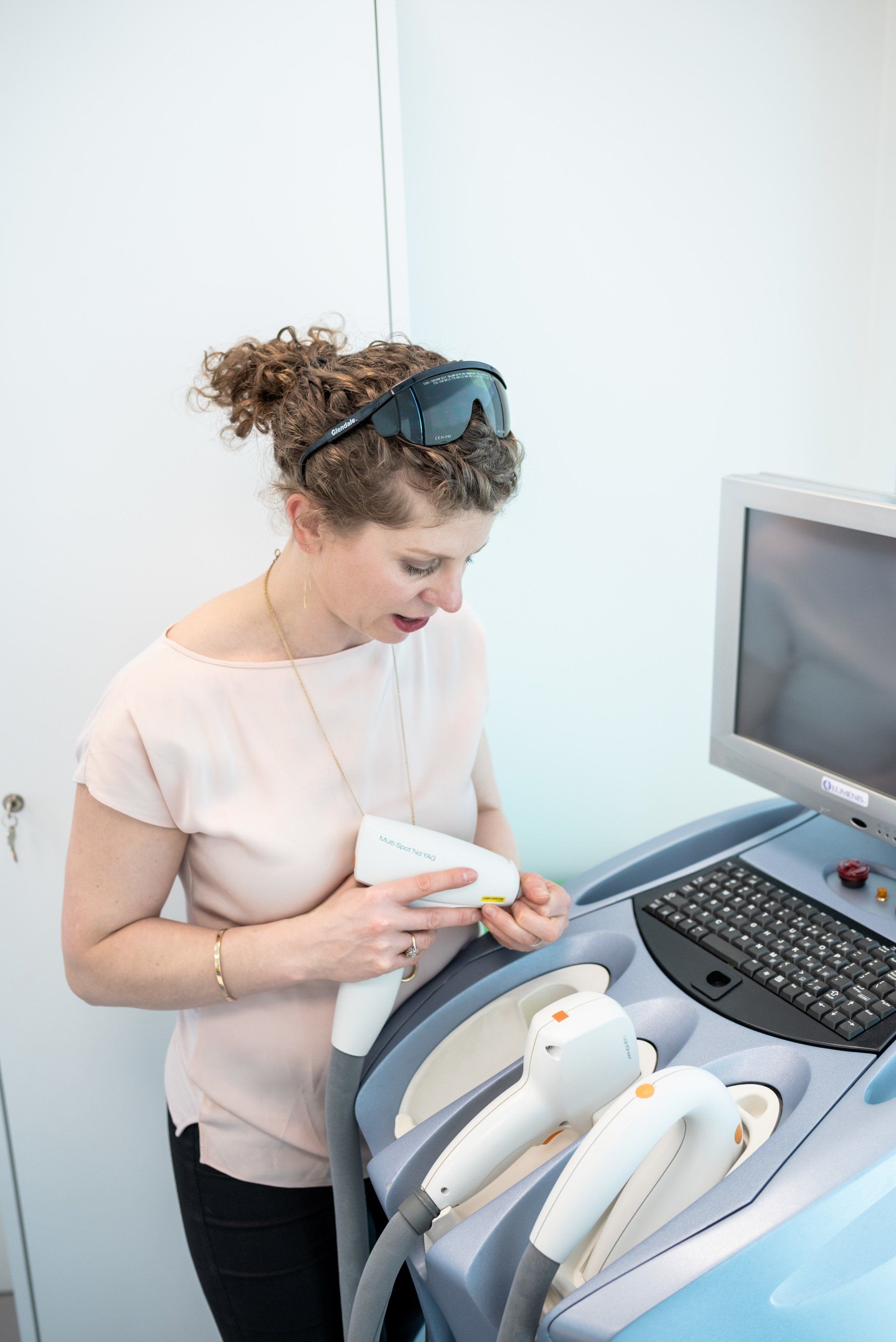
LASER HAIR REMOVAL
Permanent reduction in hair density is achievable using laser treatment. Our diode laser, used for permanent hair reduction, is considered the most effective device for this purpose available. It can be used for type I to III skin types, and with caution, some patients with type IV skin may be able to receive this treatment.
The number of treatments depends on your skin type, hair type and colour, and the location of the hair to be removed. Typically, six treatments, performed four to six weeks apart, are required to achieve a permanent reduction. Treating more frequently will not result in the result being achieved more rapidly. This is because the interval between treatments is designed to capture hairs in their growth phase: with only 30% of hairs actively growing at any point in time, treatments need to be carefully timed to respect the biology, and to maximise results.
It is vital that laser-treated areas are protected from the sun both before and after treatment, to prevent adverse consequences of this treatment. Please talk to us about planned trips abroad and recent sun exposure when you attend for your appointment.
Preparation for laser hair reduction
In order to get the best result from your laser hair reduction procedure, please note the following:
The treatment works by laser energy being absorbed by the pigment in the hair, which in turn heats and destroys the hair-producing cells within the follicle. Therefore the hair must be visible to the laser, and present in the follicle. For this reason, bleaching the hair (which stops the light energy being absorbed), or any method of hair removal which involves removing the hair from the follicle (plucking, tweezing, waxing, threading), will render the area temporarily unsuitable for laser treatment. The area for treatment may be shaved, ideally 2-3 days before. A “five o’clock shadow” amount of hair regrowth is ideal.
If the hair is too long, the laser treatment can be more uncomfortable, and less effective. Therefore, we suggest that you do trim the hair in the area to be treated before your appointment. A hair length of 2-4 mm is about right. For your first treatment, we suggest you leave a small patch (2cm x 2cm) of “typical” hair a bit longer, to allow us accurately judge your hair colour and texture.
There should be no tan, either real or out of a bottle on the area to be treated. If you have had a suntan in the six weeks before treatment, please let us know, as even after a tan has faded, the pigment cells are active within the skin, and treating at that time could result in unwanted side-effects from treatment.
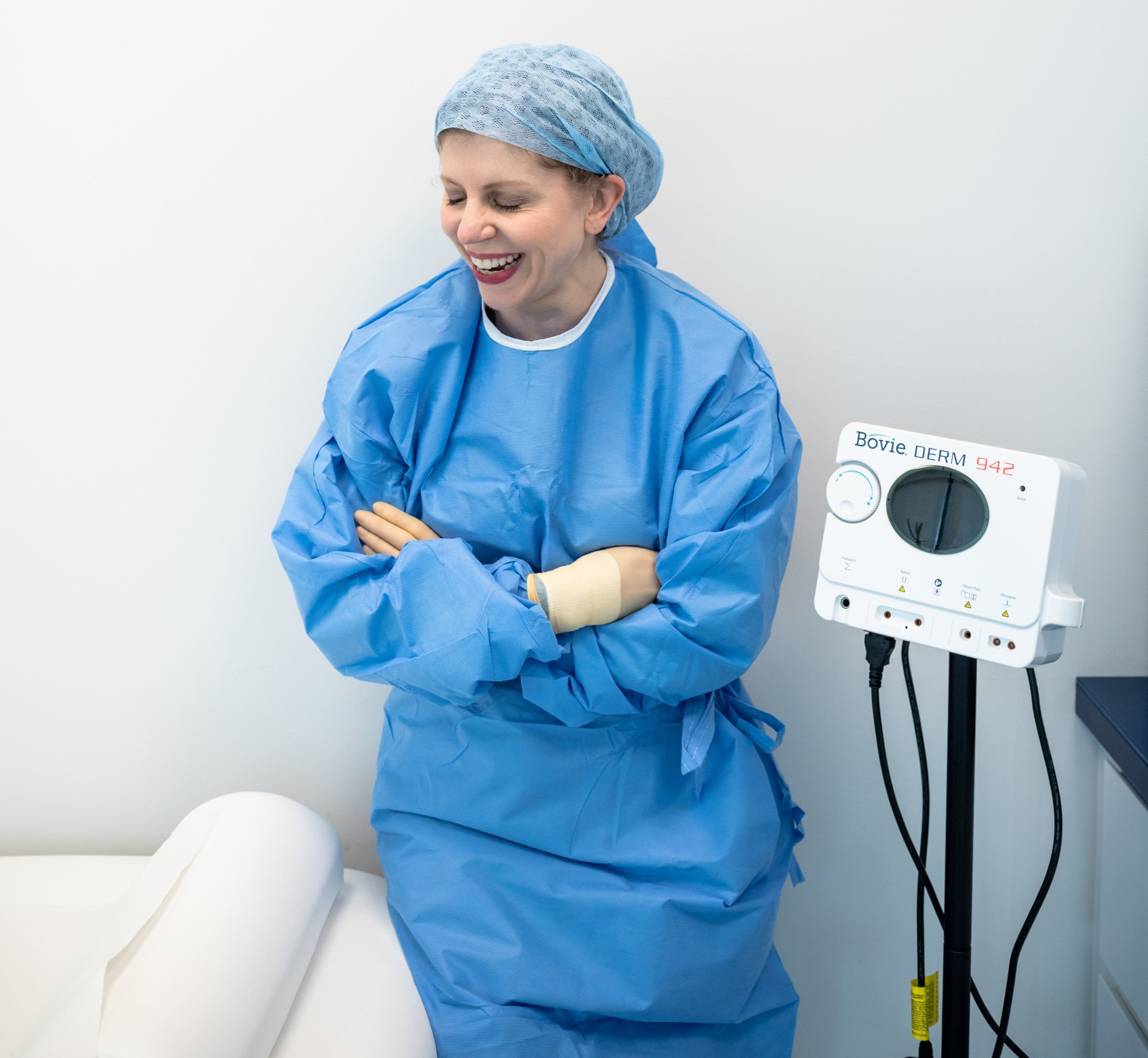
MEDICAL LASER HAIR REDUCTION
Laser hair reduction may be required by individuals for a variety of medical reasons. These include PCOS (polycystic ovarian syndrome), or as part of the transition process for transgender individuals. Standard approaches to laser hair removal, as employed in beauty salons, etc., do not commonly take into account the difference in how people presenting for hair removal in this context require to be treated, both in terms of laser treatment parameters, and frequency of treatment. We may also be able to help with respect to skin care advice, or information regarding combining hair removal treatments with other procedures. You will also be guaranteed the discretion and privacy that is standard in the medical profession.
PCOS
Polycystic ovarian syndrome is a condition which is commonly associated with excess hair growth. This excess hair can occur on the face, chest, back, and other areas. It can be very distressing for affected individuals. We use a combination of lasers, at appropriate intervals to help control the hair growth. Complete, permanent hair removal is rarely achievable, but substantial reductions in the amount of hair, with a concomitant reduction in the necessity to use other methods of hair removal such as shaving, is a realistic goal. For most patients with PCOS, relatively prolonged courses of treatment are required for optimal results, with top-up treatments at varying intervals necessary to maintain the result.
Preparation for laser hair reduction
In order to get the best result from your laser hair reduction procedure, please note the following:
The treatment works by laser energy being absorbed by the pigment in the hair, which in turn heats and destroys the hair-producing cells within the follicle. Therefore the hair must be visible to the laser, and present in the follicle. For this reason, bleaching the hair (which stops the light energy being absorbed), or any method of hair removal which involves removing the hair from the follicle (plucking, tweezing, waxing, threading), will render the area temporarily unsuitable for laser treatment. The area for treatment may be shaved, ideally 2-3 days before. A “five o’clock shadow” amount of hair regrowth is ideal.
If the hair is too long, the laser treatment can be more uncomfortable, and less effective. Therefore, we suggest that you do trim the hair in the area to be treated before your appointment. A hair length of 2-4 mm is about right. For your first treatment, we suggest you leave a small patch (2cm x 2cm) of “typical” hair a bit longer, to allow us accurately judge your hair colour and texture.
There should be no tan, either real or out of a bottle on the area to be treated. If you have had a suntan in the six weeks before treatment, please let us know, as even after a tan has faded, the pigment cells are active within the skin, and treating at that time could result in unwanted side-effects from treatment.
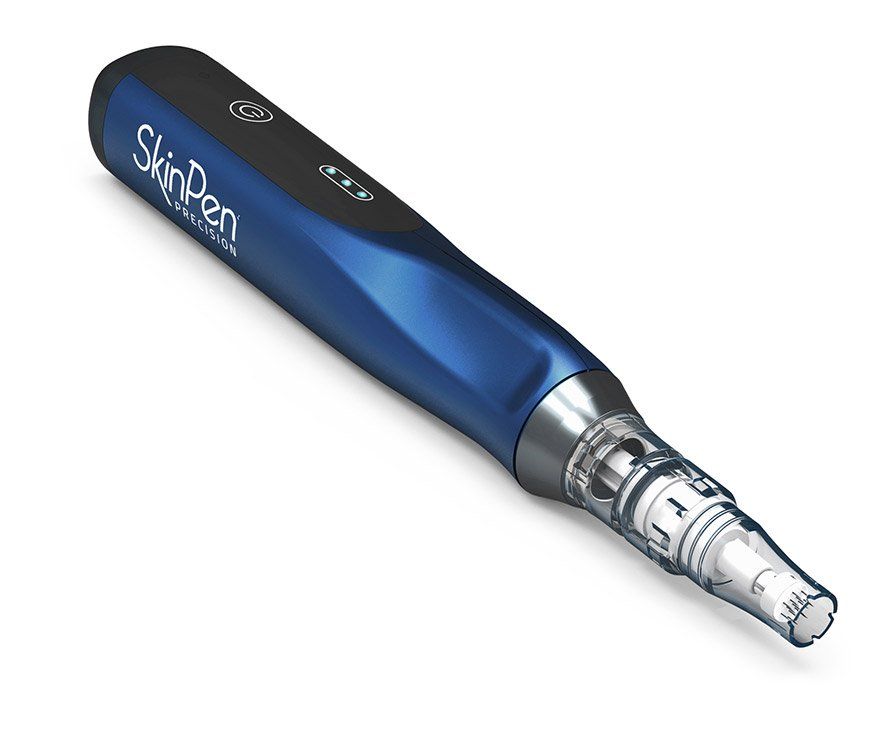
MICRONEEDLING
Microneedling helps to stimulate the production of new collagen in the skin by puncturing the dermal layer with controlled micro-needles similar to acupuncture needles. This form of micro-injury triggers the skin to produce new collagen. Microneedling is a natural, safe and effective way to improve texture and tone of ageing skin, acne scarring, sun-damage, pigmentation and stretch marks. Topical products will penetrate the skin more effectively, helping them to work more efficiently. This procedure stimulates the skin to regenerate itself naturally and safely, creating smoother, brighter, healthier and younger looking skin.
What is involved?
A topical anaesthetic cream is applied to your skin for 45 minutes prior to treatment to numb the area. Treatment time is 20-30 minutes. During the treatment, the microneedling device is passed over the areas for treatment. You may feel pressure, but should not experience discomfort.
What happens after treatment?
Following treatment the skin will be red for 24 hours, and some mild swelling will be visible especially around the eye area. You will need to use a sun block factor 30-50 daily following treatment. The skin may exfoliate lightly after 3-4 days and will become tighter. The stimulation from skin needling can also help even out pigmentation and enhance micro circulation leaving you with a smooth and clear complexion. It also stimulates the production of collagen and assists in the absorption of cosmetic products.
Other information
Micro-medical needling has significantly less downtime than invasive treatments such as fractional laser resurfacing or deep medical peels, which means you can resume your normal activities quickly. It is, however, less effective than such treatments for certain types of scarring and other skin concerns. We will discuss with you at the time of your consultation, the likely outcome of treatment in your particular case. It is safe to use on darker skin types with less risk of post-inflammatory hyperpigmentation but darker skin will have to be prepared usually one month before treatment with medical grade products.

PLATELET RICH PLASMA (PRP)
Platelet Rich Plasma Therapy for Skin Rejuvenation
Platelet-rich plasma is a safe, natural, anti-ageing treatment, which makes use of the growth factors and healing cells in your own blood. It is a non-toxic, hypoallergenic treatment, which avoids the use of any synthetic ingredients or products. PRP is an established treatment in many fields of medicine, including facial aesthetic surgery, wound healing, dentistry, and orthopaedic surgery.
PRP can be used as a stand-alone procedure, which will leave skin looking smoother, younger and revitalised. It can also be used in conjunction with other treatments such as surgery, laser and light treatments, and chemical peels. At Fitzgerald Plastic Surgery, our standard offering includes an IPL treatment following your PRP treatment, to enhance and stimulate the results.
What is PRP?
PRP stands for Platelets Rich Plasma, it is a high concentration of platelets in a small volume of plasma. Platelets are small but powerful: they contain growth factor proteins that help stimulate new collagen and can help to reverse the signs of ageing.
What areas can be treated?
Platelet derived growth factors can help to rejuvenate loose sagging skin of the face. It is safe for the delicate under eye area and ‘crepey’ eyelids, fine lines and wrinkles of the lip lines, neck, décolletage, hands, surgical scars and acne scars. Great results can be seen around the eye area in particular.
What is involved?
Platelet rich plasma therapy is a minimally invasive cosmetic procedure performed in one session, which typically lasts an hour. We take a small amount of blood (about 10ml) from your arm, similar to any other blood test you may have had in the past. Your blood is then immediately ‘spun down’ in our centrifuge in order to separate the red blood cells and other blood components from the platelet rich plasma the straw coloured serum that contains your body,s repair cells. Your skin is numbed with a topical local anaesthetic cream to help minimise any discomfort.
The platelet rich plasma serum is then injected with a very small, fine needle or cannula into areas of skin to be treated. Your natural repair factors are thus delivered directly into areas of your face where the skin is thinning, wrinkled, sagging, discoloured or damaged or scarred. The injection process takes 15-30 minutes and all areas are usually treated, such as the face, neck décolletage or back of the hands.
Are there any side effects?
Redness and some swelling are to be expected for a day or so following treatment. There is a risk of bruising, and therefore, like all our injectable treatments, we advise you to avoid having this treatment done within a couple of weeks of any social or other occasion for which it would be completely unacceptable to you, to have any bruising in the treated area. Should a bruise occur, it is perfectly fine to apply make-up to the area, from the day following treatment, in order to help disguise the bruising.
Excess alcohol, blood-thinning medication, non-steroidal anti-inflammatory medication, oral steroids, and high doses of vitamin C, E, garlic, ginkgo, and ginseng, should be avoided in the week before this treatment. (If you have been prescribed blood-thinning medication, please note that we do not recommend discontinuing that medication, without consultation with the prescribing doctor).
What results can I expect from a PRP treatment?
Results can be seen from 2 weeks this also depends on the condition of your skin prior to the treatment. Improvement continues up to one year (or longer) after a treatment, as the collagen, etc., stimulated by the PRP injection matures and becomes more robust.
Cellenis PRP
At Fitzgerald Plastic Surgery, we pride ourselves on using the safest, most effective, and highest quality products. We have selectied Cellenis® PRP.
Cellenis® Platelet Rich Plasma (PRP) is a
proprietary PRP technology based on blood
separation according to density using a
unique proprietary separation gel.
The system allows for the preparation of pure PRP with optimal platelet concentrations and cellular content. Virtually all red blood cells are eliminated from PRP fraction and the concentration of pro-inflammatory granulocytes having undesired components is highly reduced. Over the days and weeks following the Cellenis® PRP treatment, growth factors released by the platelets stimulate the growth of new blood vessels and more collagen growth, thickening the epidermis and providing an improvement in the skin’s texture and tone.
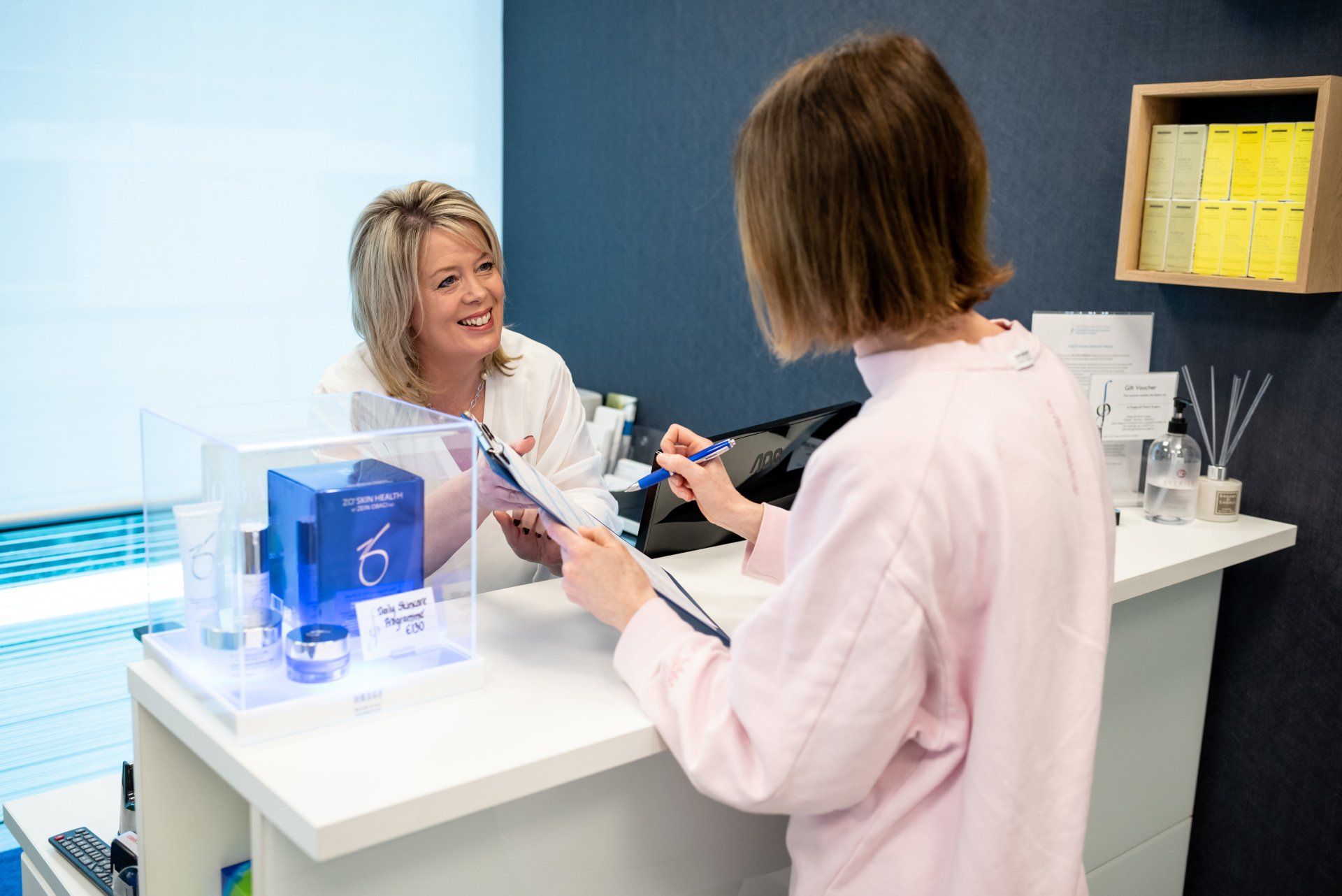
MEDICAL MICRODERMABRASION
This luxury red carpet treatment will leave you fresh faced, with no downtime and instant results.
Microdermabrasion is a non-invasive treatment, which allows for deep exfoliation of the skin, without the use of chemicals or substantial down-time. In addition to the exfoliation, new collagen formation is stimulated, meaning there is a longer-term benefit as well as the immediate effect seen. It is suitable for both men and women, and can safely be used during pregnancy. It offers improvements in skin texture and tone, can treat congestion, and is an alternative to chemical peels for the removal of dry or scaly skin. There are no needles, and it is a very well-tolerated treatment. A patch test is not required.
What is involved?
Your skin is carefully assessed, and a detailed history of your skin concerns taken. It is then cleansed and the microdermabrasion device passed gently over the skin. A fine jet of medical-grade crystals are vacuumed against your skin, gently lifting and separating dead skin cells from the fresh, healthy tissue that lies beneath. We often combine this treatment with a mild fruit acid peel, to enhance and prolong the benefits of the treatment.
Our Equipment
Our medical microdermabrasion device is the Viora Pristine microdermabrasion device. Based on the dual mechanisms of exfoliation and adjustable vacuum stimulation, the Pristine system exfoliates dead cells from the skin surface, cleaning the pores from inside out, and stimulating local blood flow and collagen production. The treatment renders a firm, fresh and more even complexion that continually improves over time.
The Pristine treatment is free of irritations and discomfort, allowing you to benefit from a fully costomisabele, clean, aesthetic procedure that is relaxing, enjoyable, and most impotantly - delivers results from the very first treatment.
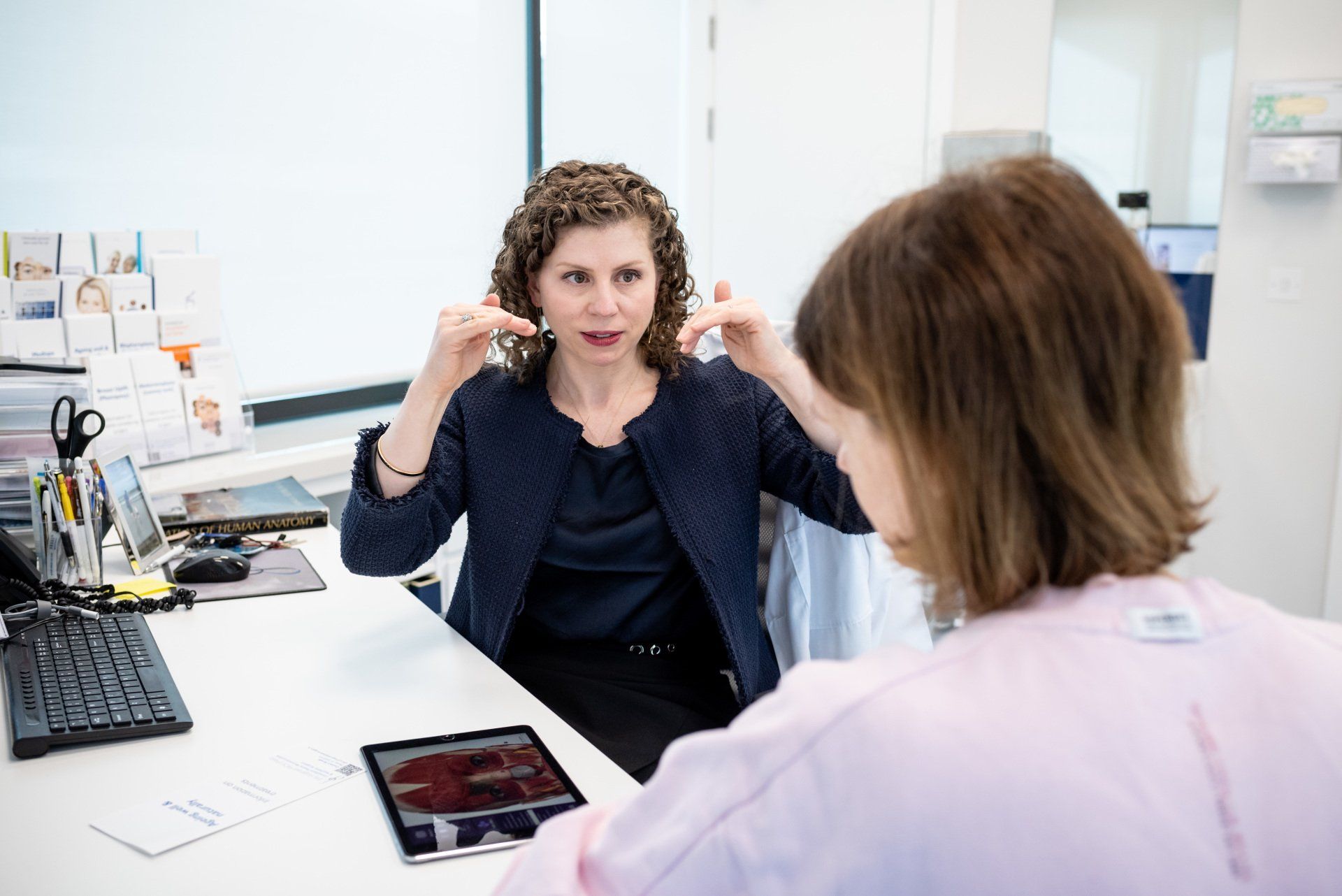
ANTI-WRINKLE INJECTIONS
Introduction
Anti-wrinkle injections are used for the treatment of dynamic wrinkles of the face (those that appear on movement), such as forehead and frown lines, crows’ feet, and some lines around the lips. Such treatments are one of the most commonly performed aesthetic treatments worldwide. These formulations use purified forms of the medication, in safe, low doses. I use only the highest-quality, thoroughly-researched products for my patients. It is an exceptionally safe drug, which has been in use since the 1970s for the treatment of conditions such as squints, cerebral palsy, and torticollis (neck spasm). It is also an excellent treatment for excessive underarm sweating (hyperhydrosis), and has replaced invasive surgery as the “gold standard” treatment for this condition. While it is potent at high doses, at the doses used for cosmetic procedures, serious side effects are vanishingly rare.
My approach
This is one of the easiest cosmetic procedures to undergo – the downtime is minimal, and the effects (almost) instant. It is not, however, one of the easiest procedures to do – if your goal is to provide an excellent rather than an average or mediocre result. Not every face is the same, and injecting every individual in the same places with the same doses will result in suboptimal results. I carefully analyse your face, looking at the strength and precise location of the tiny facial muscles, the way these muscles work together, any pre-existing imbalances, your skin quality and underlying bone structure. I take into careful consideration your specific treatment goals, bearing in mind that most Irish patients prefer to avoid an obviously “done” look. I will explain to you my preferred treatment plan, and most importantly, make sure you understand why I am taking the approach I suggest. My mantra, particularly on your first treatment, is to always err on the side of caution. A follow-up visit two weeks later is always advised: further small doses may need to be administered at this time.
My training as a plastic surgeon, and in particular my time spent as the DAFPRAS (Dutch Association for Facial Plastic Reconstructive and Aesthetic Surgery) fellow has equipped me well to provide this individualised approach to anti-wrinkle injections to the face. I have worked with one of the top facial palsy reconstructive surgeons in the UK, at the Royal Free Hospital in London. There, I was exposed to the use of this medication injections for the improvement of facial asymmetries and tics in patients with paralysis due to a variety of conditions including Bell’s Palsy, and I am happy to see such patients for this treatment.
The treatment
The areas that can be treated are forehead and frown lines, crows’ feet, “bunny lines” on the nose, lines of the upper lip, an overactive chin muscle, and platysmal bands (vertical lines formed by the thin muscle at the front of the neck). Under-eye lines are not usually suitable for treatment, nor are deep lines on the cheeks, between the nose and mouth, or those coming from the corners of the mouth. These areas may be suitable for treatment with fillers or fat injections.
Following a detailed discussion of your treatment goals, I will perform a number of injections to the area to be treated. This usually takes no more than 5 minutes. I carefully document the precise location of the injections you receive, in order that subsequent treatments can be planned based on the results achieved. I have never encountered a patient who was unable to cope with the injections, which can sting. If you are particularly nervous about having these injections, I suggest that you attend for a preliminary consultation, during which I can go through some options to help you deal with this.
Consequences and limitations
Immediately following the treatment, you may expect to have some redness and bumps at the injection sites. These will fade within an hour. Occasionally, some bruising may occur (most commonly in the crows’ feet area). This will fade over a number of days, and can be covered with make-up. Most people find that they can feel the effects (as a stiff or tight sensation) before they see them: for most people, an effect will start to become apparent from around day four. The full effect will be seen between 10 and 14 days, which is why I schedule a follow-up visit two weeks after the initial treatment. For the same reason, if you are having your treatment for a specific event, I usually recommend that you have your treatment at least three to four weeks before, in order that any bruising will have disappeared, and any fine adjustment/ top-up injections will have had a chance to take effect. If you have had your treatment with me in the past, two weeks should be adequate. The effects usually last for about 4 months, although there will be some individual variation in this.
Side effects of this treatment are rare. Some people feel some ‘flu-like symptoms for a few days, or a little nauseated after the procedure, or develop a headache. Occasionally a temporary drooping of the eyelid can occur. This may last a few weeks, but will always resolve. Special eyedrops can be prescribed during this time to help lift the lid back to the normal position. Drooping of the eyebrow can also occur, but it too will resolve. Again some patients experience some double vision after treatment which resolves with time and is very rare. In extremely rare cases patients have developed an allergy to the treatment, while others have shown resistance, i.e. it causes little or no effect on the treated muscles.
Allergic reactions to the medication are exceptionally rare, and if you have had such a reaction in the past, you should not have further treatments. You should not have treatment if you have had previous unsuccessful treatment with this medication, if you have a skin infection in the area to be treated, if you are pregnant, trying to get pregnant or breastfeeding, if you have any neuromuscular disease (e.g. Myasthenia Gravis, Lambert-Eaton Syndrome, motor neuron disease), if you are taking aminoglycoside antibiotics or other medications which interfere with neuromuscular transmission (ask your pharmacist or the doctor who prescribed the antibiotic or medication if you are unsure), or if you are taking anticoagulants (e.g. Warfarin, Plavix). If you are taking Aspirin, Vitamin E, gingko biloba or St John’s Wort you must stop these medications 10 days prior to treatment.

DERMAL FILLERS
Introduction
Dermal fillers are used to ‘plump out’ lines, folds, and wrinkles of the face. They are most effective for static lines – that is ones that are apparent when the face is at rest. Most commonly, they are used for lines in the lower half of the face, with botulinum toxin injections being the first choice for lines in the upper face. Having said that, these two treatments can offer excellent results in both the upper and lower face, used either individually, or in carefully-tailored combinations. Fillers may also be used to enhance the lips, and to improve skin texture and quality.
Many people shy away from the idea of fillers. They have seen examples of “trout pouts”, “pillow cheeks”, or other unnatural results. These results may occur as a result of using too much filler, or putting it in the wrong place. Other adverse results are associated with the use of old-fashioned collagen injections (which had a relatively high rate of allergic reactions), or the use of permanent fillers. I do not use such products.
Many of the fillers I use are hyaluronic acid (HA) based. HA is a naturally-occuring substance in our bodies, and a synthetically-manufactured version is used in dermal fillers. The products I use are FDA-approved, with an excellent safety profile. The effects can be expected to last between six months (in more dynamic areas such as around the mouth), to a year and sometimes longer. Should a patient wish to get rid of the filler before then, it can usually be dissolved, but it should be noted that dissolution may nto be straightforward, and carries certain risks.
Calcium hydroxylapatite (Radiesse) fillers are also used, usually in a dilute form. Utilised in this manner, they act as a biostimulant, causing synthesis of collagen and elastin. Tightening of the skin of the face, decolletage, arms, hands, etc., can be achieved, and treatment is required every two years approximately.
My approach
My goal is always to provide a subtle, natural result, which enhances your facial features and is specifically tailored to your treatment goals. I carefully analyse your face, looking at any pre-existing imbalances, your skin quality and underlying bone structure. I take into careful consideration your specific treatment goals, bearing in mind that most Irish patients prefer to avoid an obviously “done” look. I will explain to you my preferred treatment plan, and most importantly, make sure you understand why I am taking the approach I suggest. My mantra, particularly on your first treatment, is to always err on the side of caution. I want us both to be delighted with the result, and will always take the time to ensure we are both ‘singing from the same hymn sheet’ when it comes to goals and expectations.
I consider that one of the reasons that people are disappointed with the results of fillers is because they are used inappropriately – the wrong volume or placement used, or on occasion, because they are asked to do more than they are capable of. As a plastic surgeon, who can offer the full spectum of facial revitalisation treatments and procedures, I will not recommend a filler when I know that it is not going to give you your desired result.
The treatment
Fillers are used to treat lines, wrinkles, and folds of the facial skin. Lines are not usually eradicated, but substantially softened. They can also be used for lip augmentation, outlining, and in the treatment of fine lines around the lips and mouth. Courses of fillers may be used to improve the skin quality of areas such as the décolletage, cheeks, and hands. Volume in the cheek and chin area may be augmented through the use of fillers. We will discuss whether fillers are the appropriate treatment to fulfill your goals at the time of your initial consultation.
In order to decrease the discomfort associated with the procedure, local anaesthetic is used, either in the form of a cream or a simple injection (similar to that one would have at the dentist) in advance of the injections. The filler is then slowly and carefully placed into the desired area, via a number of injections. I encourage you to participate in this process, and will often have you look in a mirror as we go along.
Consequences and limitations
Immediately following the treatment, you can expect some swelling and numbness. The lips are particularly prone to swelling, which may worsen over a couple of days before gradually settling. Unless otherwise instructed, you should refrain from massaging/ rubbing the area for 24 hours following treatment, and excess pressure (e.g. lying face-down on a massage table) should also be avoided. Some bruising may occur at the sites of injection, and for this reason (combined with the expected swelling), I advise you to have your treatment done a minimum of two weeks before any major event/ occasion on which you would be self-conscious of these side-effects.
Allergic reactions to HA fillers are exceptionally rare. Very occasionally (1 in 20000 treatments), patients may experience a hypersensitivity reaction, characterised by redness, swelling, and itching. Even more rarely (1 in 65000 treatments), a granulomatous reaction at the injection site may occur. Mild superficial infections at the injection site are possible, although rare. I will discuss any and all concerns you may have in detail with you, prior to embarking on a course of treatment.
The results from fillers are not permanent. As a general rule, they last somewhere between nine and 18 months, and somewhat less than that (maximum six months) around the mouth. There is growing evidence that the presence of HA encourages your body to form new collagen in the sites that have been injected, and it is certainly true that patients who have had repeated treatments find that they can space their treatments further apart as time goes on, as the effect from each treatment is more sustained.
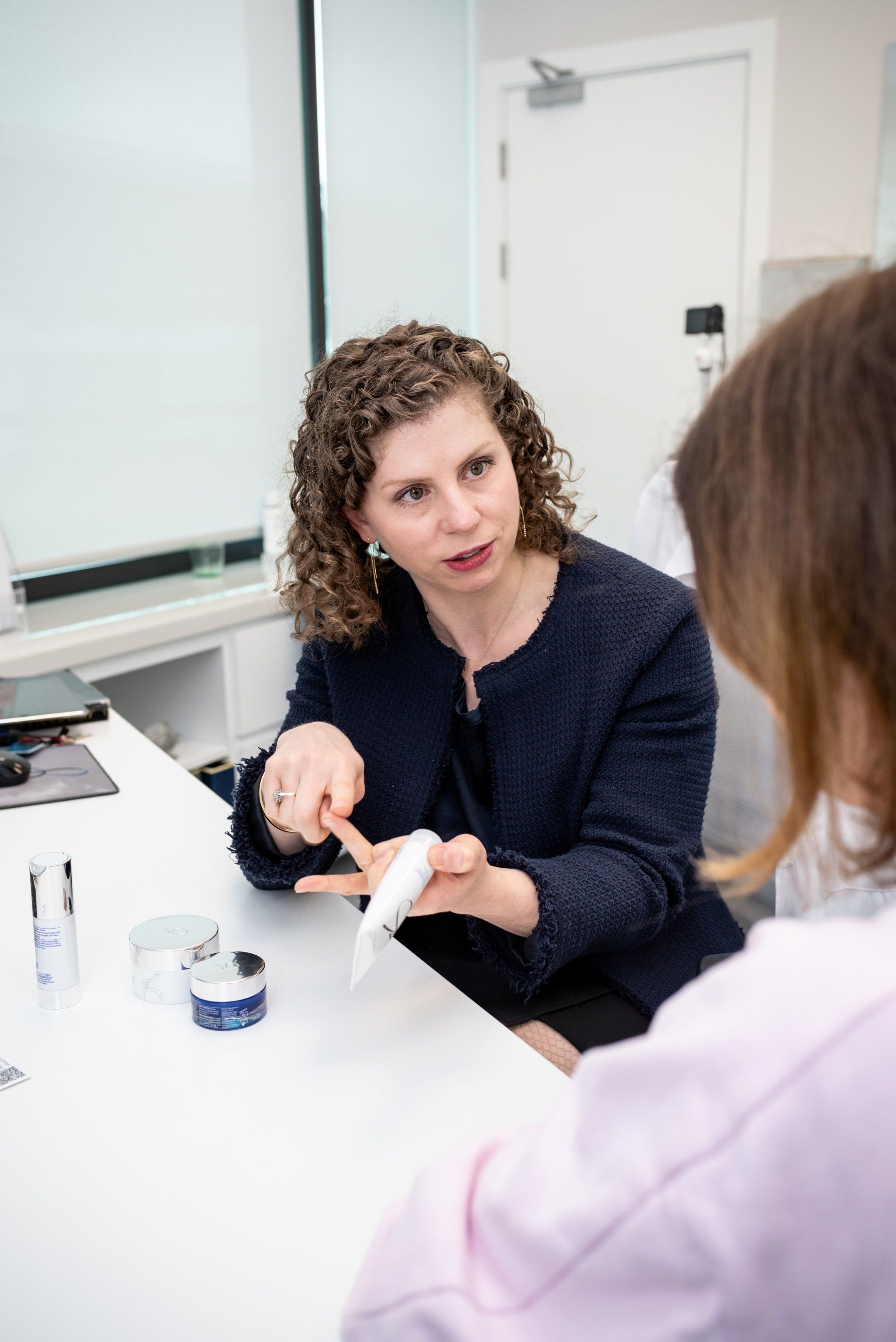
AFTERCARE
Our guide to getting the safest and best results from your treatment
What are fillers?
Dermal fillers are composed of a clear gel, known as hyaluronic acid (HA). HA is naturally occurring and abundantly present within our bodies. It is a very hydrophilic, or water-loving molecule, which accounts for its ability to give plumping and hydration to tissues. The molecules of HA are stuck to each other during the manufacturing process, and the number and type of bonds between the molecules determines how stiff, thick, or pliable a particular filler is. Stiffer fillers are best used deep in the tissues, for volumising, while softer and more pliable formulations may be used in more mobile areas such as the lips. The softest formulations do not create any volume, but are used to deeply hydrate the skin from within. Selection of the correct filler is paramount to achieving the desired result. At Fitzgerald plastic surgery, only FDA-approved fillers are used: these are the highest quality products on the market, and the ones which have been tested most rigorously for safety.
Who does the treatments?
At Fitzgerald Plastic Surgery, all dermal and lip filler treatments are performed by consultant plastic surgeon, Ms Éilís Fitzgerald.
Why does it matter who does the treatment?
Dermal fillers are classified as a medical device, which unfortunately means that they are not subject to the same controls as prescription medications. As hard as it is to believe, the current situation in Ireland it that it is entirely legal for individuals with no medical training whatsoever, to purchase and inject these products. This is a potentially very dangerous situation, as the injecting individual has no medical knowledge or expertise to recognise or to treat complications from the treatment. In addition, they have no recognised training in anatomy or facial aesthetics, that would permit them to perform these treatments correctly. Such individuals cannot legally inject the substance which is used to dissolve fillers, as it is a prescription medication, which can only be administered by doctors. The ability to dissolve filler immediately should a problem arise is an essential part of being able to safely perform these procedures for people.
While these products and treatments are very safe, there are certain risks associated with treatment. They also need to be placed in such a manner that respects natural anatomy, and facial aesthetic principles. Plastic surgery and dermatology are the only recognised specialities in which doctors are taught these principles over the course of many years. This level of training simply cannot be matched by doctors from other specialities (and none), who complete as little as a one day training course before terming themselves “cosmetic doctors” or similar. Please beware and be aware of who is doing your treatment. Ensure your doctor is on the Irish Medical Council’s Specialist Register in either Plastic, Reconstructive & Aesthetic Surgery (as Ms Fitzgerald is), or in Dermatology.
Only a fully qualified plastic surgery consultant such as Ms Fitzgerald, or a consultant dermatologist, has undergone the years of training in respect of the anatomy and aesthetics of the face, to permit these treatments to be performed with maximum efficacy and safety.
Preparing for your treatment
- Certain medications make you more prone to bleeding and bruising; these include aspirin, ibuprofen, Difene, and other NSAIDs (non-steroidal anti-inflammatories). Please do not take them for a week before treatment.
- If you are on any prescription blood-thinners, including aspirin, warfarin, plavix, Eliquis, Pradaxa, etc., you must check with the prescribing doctor if it is safe for you to stop these medications for treatment. If you are advised against stopping your medication, please do not do so. This may mean you are unsuitable for filler treatment. Please contact the office if you are unsure.
- If you take fish oils, evening primrose oil, high doses of vitamin C or E, St. John’s Wort, ginko, or ginseng, you should stop taking these a week before treatment, to reduce the risk of bruising.
- It you wish, you can take arnica by mouth for the week before and following your treatment, to reduce the chance of bruising. Unfortunately, we cannot absolutely guarantee that bruising will not occur. Please bear this in mind when planning the date of your appointment in relation to social events, etc.
- Avoid topical products such as Tretinoin (Retin-A), Retinols, Retinoids, Glycolic Acid, or any “Anti-Aging” products for 3 days prior
- Avoid waxing, bleaching, tweezing, or hair removal cream on the area to be treated for 3 days prior
- Do not drink alcoholic beverages for 24 hours prior to treatment
- If you have previously suffered from facial cold sores, there is a risk that the needle punctures could contribute to another eruption of cold sores. Please let the office know at the time of booking your appointment if you are prone to cold sores: you may require medication taken before your filler treatment, to reduce the risk of an outbreak.
- Dermal fillers are not suitable if you are pregnant, allergic to any of the ingredients, or have a diagnosis of certain neurological disorders. You will be asked to complete a screening health questionnaire in advance of your treatment. Should you have any questions, please just ask in advance of treatment.
Day of treatment
While many people choose to attend without any make-up on their face, your skin will be thoroughly cleansed before the procedure, so there is no need to come bare-faced if you do not wish to do so. You will be advised against applying foundation, etc., for several hours after the procedure. Eye make-up does not need to be removed.
Should you wish to have numbing cream applied prior to your treatment, please be aware that you will need to attend up to an hour in advance of your scheduled appointment time with Ms Fitzgerald to have this applied. This is because it takes some time to be fully effective. Please ensure that you inform us of your requirements in this regard, as we cannot otherwise guarantee that adequate time will be available for application and efficacy of the cream.
Immediately following treatment
- Immediately after the treatment, there may be redness, bruising, swelling, tenderness, and/or itching near the injection site.
- Please avoid itching , massaging, or picking around the injection site, unless you have been specifically instructed to massage the area.
- Swelling, redness, bruising, etc. is generally considered to be normal, and should subside rapidly within a few hours to a few days after treatment. This is normal and generally disappears within a few hours to a few days. If these symptoms last more than 3 days, please contact the office.
- We will provide you with an ice pack at the time of treatment. Many people find it useful to continue applying cool compresses at home afterwards (a bag of frozen peas works well). Arnica cream (available for purchase at the office), and/ or arnica tablets can help with bruising. Some people find the herbal supplement bromelain useful to help bruising resolve.
- You may take paracetemol to reduce any pain as necessary (not required in most cases)
For the rest of the day
- Avoid any activity that makes you become red in the face – be that strenuous exercise, a sauna, or a warm environment. Yoga-lovers should avoid inverted poses. This is to prevent additional bruising. Wait until all swelling and redness have resolved before going back to these sorts of activities.
- Avoid drinking alcohol.
- Apply topical arnica if you wish
- Avoid pressure to the treated area(s), other than massage as directed during your consultation.
- If there is a visible bump, you can massage the area.
- Sunscreen and make-up can be worn: be careful to avoid excess pressure or rubbing during removal of same
Additional aftercare instructions
- It is safe to fly from the day of treatment (although, if only to avoid yourself the stress of getting to the airport on time, we advise waiting until the next day)
Contact us immediately if…
- You experience fever and/or chills
- If the area appears red, hot to the touch, and “angry” looking.
- You have severe pain or increasing pain
- You notice discoloured blotches in areas not injected or blanching (whiteness) of injected areas
- You notice new onset visual disturbance or loss
If you are concerned, please do not email, but contact us by telephone on 015553777. Office hours are Tuesday to Friday, 9am to 5pm. If you have concerns outside of those hours, you may contact the Beacon Hospital on 012937535.
How long do fillers last?
Depending on the area injected, the product used, and previous or concurrent treatments, results can be expected to last from about six months (for lips and skin retexturing treatments) to 12-18 months for volume restoration.
How can I enhance my result?
Glowing healthy skin is, without question, the number one thing to enhance the result of any treatment. As part of our holistic approach to facial rejuvenation. We encourage all patients who undergo an injectable treatment with Ms Fitzgerald a complimentary skin health consultation with our expert aesthetic nurse. This consultation can take place at any time in the four weeks following your injectable treatment and many people find it works well to schedule it in conjunction with their review appointment with Ms Fitzgerald. We would be delighted to provide you with further information on request.
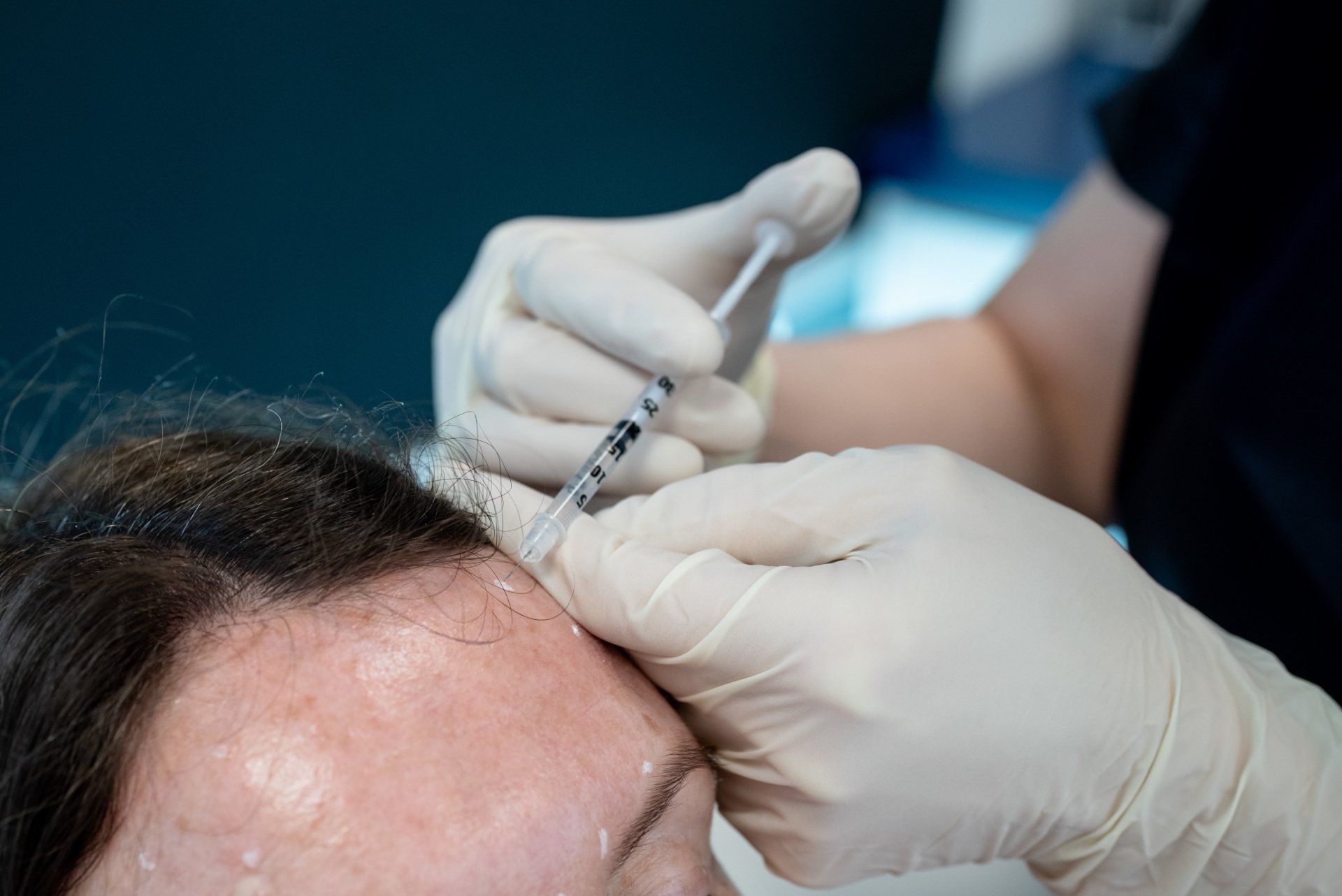
EXCESSIVE SWEATING
Treatment of excessive sweating (hyperhidrosis)
What is hyperhidrosis?
Excessive sweating (hyperhidrosis) is a condition in which the amount and frequency of sweating is far greater than it needs to be, in order for the body temperature to be regulated. The resultant “sweat patches” can be a source of embarrassment, and impact on individuals’ self-confidence, clothing choices, and even participation in social activities.
What areas can be treated?
While this conditiion can effect areas such as scalp, face, hands, feet, etc., the only area for which we offer treatment, is the armpits.
How can it be treated?
Strong deodourants, topical products, iontophoresis, and even surgical division of the nerves to the sweat glands are treatments for this condition. In the last 15 years, botulinum toxin injections have been used, and this is now a proven and effective treatment, regarded as the “gold standard” for the management of axillary hyperhidrosis (excessive sweating of the armpits).
Are any tests required before treatment?
Individuals considering this treatment should, in the first instance, talk to their GP as to whether any tests are required to outrule a cause for the excessive sweating (certain medical conditions, for example an overactive thyroid, can cause hyperhidrosis).
What happens during a treatment?
The treatment itself involves multiple tiny injections to the hair-bearing area of the armpit, and takes less than 10 minutes. We suggest shaving your armpits 3-4 days before treatment, so as to have the area as clean as possible, while allowing Ms Fitzgerald to clearly see the extent of the hair-bearing area.
What can I expect following treatment?
Following treatment, you will be advised to avoid strenuous exercise, long hot baths and showers, and the use of perfume or deodorant for 24 hours.
The treatment will start to work from about four to seven days, and effects last approximately four months. The treatment can be repeated as often as necessary. While it is not universally the case, a number of patients receiving this treatment two or three times, do notice a permanent reduction in their sweating over time. This should not however be considered an expected outcome of treatment, but rather a significant bonus.
Will my health insurance cover the cost of treatment?
Unfortunately, this is not a treatment that is covered by health insurance. As it is a treatment for a medical condition, however, many patients will include the expense on their Med1 forms.
